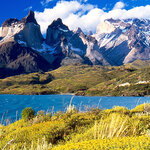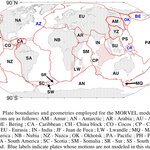Geology
Carried by winds high up in the atmosphere, a massive cloud of ash from the eruption of the Eyjafjallajoekull glacier in southwest Iceland has led to the closure of airports throughout the UK and Scandinavia, with further disruption in northern Europe expected later today.
The ash, which can be seen as the large grey streak in the image, is drifting from west to east at a height of about 11 km above the surface Earth. It poses a serious danger to aircraft engines; hence the airspace shut down.
The volcano erupted, for the first time since 1821, on March 20 and erupted for a second time on…

The earth has four major layers: the inner core, outer core, mantle and crust. The crust is what we need to think about here and the earth's crust is divided into 'plates' that are like puzzle pieces but are up to 50 miles thick and they are in constant motion in the earth's interior. These puzzle pieces are tectonic plates and the edges of the plates are called the plate boundaries. The plate boundaries are made up of many faults, and most of the earthquakes around the world occur on these faults. Most earthquakes are due to pressure that builds up over time and that…
An asteroid impact was likely not responsible for the extinction of the North American megafauna – such as mammoths, saber tooth cats, giant ground sloths and Dire wolves – along with the Clovis hunter-gatherer culture some 13,000 years ago, suggests a new study in PNAS.
When the last ice age came to an end approximately 13,000 years ago and the glaciers covering a large portion of the North American continent began melting and retreating toward the north, a sudden cooling period known as the Younger Dryas reversed the warming process and caused glaciers to expand again. Even though this…
Newly drilled core samples from the Antarctic Peninsula may contain ice dating back into the last ice age and could give new insight into past global climate changes.
Oxygen-isotopic ratios – a proxy for temperature, and concentrations of dust and various chemicals – including volcanic tracers, will collectively reveal past climate conditions.
The expedition in early winter to the Bruce Plateau, an ice field straddling a narrow ridge on the northernmost tongue of the southernmost continent, yielded a core that was 445.6 meters (1,462 feet) long, the longest yet recovered from that region of…

A new study in Nature Geoscience has uncovered more evidence linking regular changes in Earth's orbital cycle to changes in the planet's climate
The new analysis of ocean sediment cores from 57 locations around the world suggests that the pattern of climate change over the past million years likely involves complicated interactions between different parts of the climate system, as well as three different orbital systems: eccentricity, tilt, and "precession," or a change in the orientation of the rotation axis.
The Earth's orbit around the sun changes shape every 100,000 years, becoming…

Faint Young Sun - No Paradox
The faint young sun paradox is no paradox, according to a recent paper in Nature.
The faint young sun paradox is that the earth didn't freeze over when the sun was weaker at the time when the oceans formed. Earth's climate has been fairly constant during the approx. 4.6 billion years of earth's existence, despite the fact that radiation from the Sun is believed to have increased by 25-30 percent over that time.
Professor Minik Rosing, from the Natural History Museum of Denmark, and Christian Bjerrum, from the Department of Geography and Geology at University…

How quickly the Andes Mountains reached their current height, an average elevation of 13,000 feet, has been a contentious debate in geological circles. Some researchers claim the mountains rose abruptly and others maintain that the uplift was a more gradual process.
Paleoclimatologists writing in Science suggests that the quick-rise view is based on misinterpreted evidence. What some geologists interpret as signs of an abrupt rise are actually indications of ancient climate change, the researchers say. The confusion results when ratios of oxygen's two main isotopes, oxygen-18 and oxygen-16,…

Geologists have long thought that the rapid global cooling period nearly 13,000 years ago known as the Younger Dryas (Big Freeze) was triggered by the melting Laurentide ice sheet. But geological evidence for that theory has been lacking so far.
Now researchers writing in Nature say they have identified the mega-flood path across North America that channeled melt-water from the giant ice sheet into the oceans, triggering the Younger Dryas cold snap.
The team discovered that melt-water from the ice sheet was routed up into Canada and the Arctic Ocean, which led to huge amounts of fresh…

A team of geologists say that, in just two centuries, stunning population growth, sprawling megacities and increased use of fossil fuels have wrought such vast and unprecedented changes to our world that humans actually might be ushering in a new geological time interval they have dubbed the "Anthropocene Epoch".
Writing in Environmental Science and Technology, the team says the dawning of this new epoch may include the sixth largest mass extinction in Earth's history.
First proposed by Paul Crutzen from the Max-Planck-Institute for Chemistry more than a decade ago, the term "Anthropocene"…

Geophysicists have developed a new model of the Earth, 20 years in the making, that offers a precise description of the relative movements of 25 interlocking tectonic plates that account for 97 percent of the Earth's surface.
Dubbed MORVEL for "mid-ocean ridge velocities," the new model is detailed in Geophysical Journal International. The work builds on a 1990 study describing tectonic plate velocities. During the past 20 years, researchers have incorporated more and higher-quality data to improve the model's resolution and precision.
"This model can be used to predict the movement of…